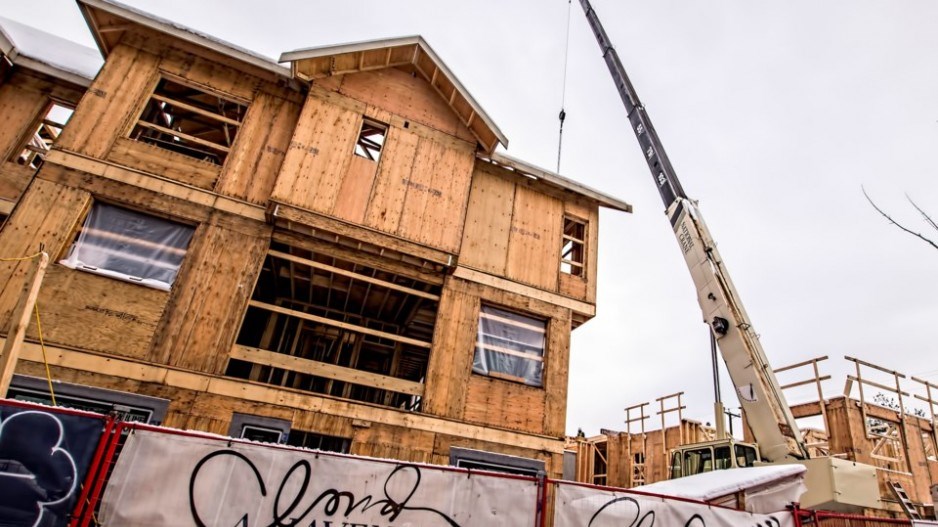Over the past year an astonishing 180,000 people moved to B.C. from other jurisdictions, a number roughly equivalent to the population of Greater Langley (the City and District combined).
During the same period, almost 40,000 new housing units were completed in the province.
The housing affordability and rental crisis in B.C. is complicated and multi-faceted, with a lengthy period of rock-bottom interest rates and the massive expansion in credit during the pandemic occupying centre stage.
But the growing wedge between the number of new homes being built in B.C. and population growth fuelled by surging in-migration is also playing a starring role in the larger housing market story.
Both permanent and non-permanent international migration have moved sharply higher in the last several years.
Over the four quarters ending in Q1 2023, some 65,000 permanent immigrants settled in B.C.
More typically, we would expect to welcome around 38,000 newcomers – this was the average number between 2008 and 2018.
Thus, the most recent annual inflow was 1.7 times higher than average over the decade predating the pandemic.
Meanwhile, the rise in non-permanent residents, comprised mostly of temporary foreign workers and international students, has been even greater.
Over the four-quarter period noted above, the number of non-permanent immigrants in B.C. soared by 114,000.
The annual net increase in non-permanent residents usually runs around 10,000. Given that the recent inflow is more than 10 times the decade-long average and that some of the jump appears to reflect catch-up from earlier pandemic related disruptions, the non-permanent resident figures should be interpreted cautiously.
Nonetheless, even if the recent inflow were cut in half the numbers would still be eye-catching.
Interprovincial migration has recently been depressing overall population growth in British Columbia.
The net outflow of 3,000 interprovincial migrants over the four quarters to Q1 2023 is tiny compared with the magnitude of international inflows.
But the dampening impact on population growth is more significant considering that B.C. normally attracts a net inflow of interprovincial migrants in the vicinity of 10,000 annually.
Even if the number of non-permanent residents in B.C. retreats from the current sky-high levels and interprovincial outflows accelerate over the next couple of years, the reality is that total in-migration will continue to outstrip new home construction by historic margins, while also adding to the pressures on public sector and other infrastructure services.
The ratio of total in-migration to new B.C. home completions has been remarkably stable over the past three decades – until recently.
Since 1991, total in-migration from all sources has averaged 56,000 while new home completions have averaged 28,000.
Even as the mix of permanent immigrants, net-non permanent residents and net interprovincial migrants changed over time, this ratio didn’t shift much, remaining anchored around 2:1.
But since 2017, it has stayed above its long term-average every year apart from 2021, when the pandemic resulted in a sharp fall in international migration.
Between 2000 and 2016, the ratio of net in-migration to home completions exceeded 2:1 on just five occasions – and never for more than two consecutive years.
But since 2017, the ratio has consistently exceeded the long-term average (six of seven years) and in 2023 reached a previously unheard of 4.4:1.
The duration and magnitude of the deviation in the ratio of total in-migration to home completions above its long-term average is striking.
It suggests that upward pressure on rents will persist and perhaps intensify in the years ahead. Population growth will also pour more fuel on home prices – even as higher interest rates have pushed B.C.’s housing unaffordability metrics into uncharted territory.
While we are skeptical about the capacity to build our way to more affordable housing in the near-term, B.C.’s current population trends are a sign that the current rate of home completions cannot be the right level.
As many industry analysts have noted, a significant and sustained expansion in supply is needed, encompassing all segments of the market, and including – importantly – rental units as well as both market and non-market housing.
Failing to act decisively on this front can only result in an even more pronounced housing supply and affordability crisis over the balance of the decade.
Jock Finlayson is the Business Council of British Columbia’s senior adviser; Ken Peacock is the council’s senior vice-president and chief economist.



